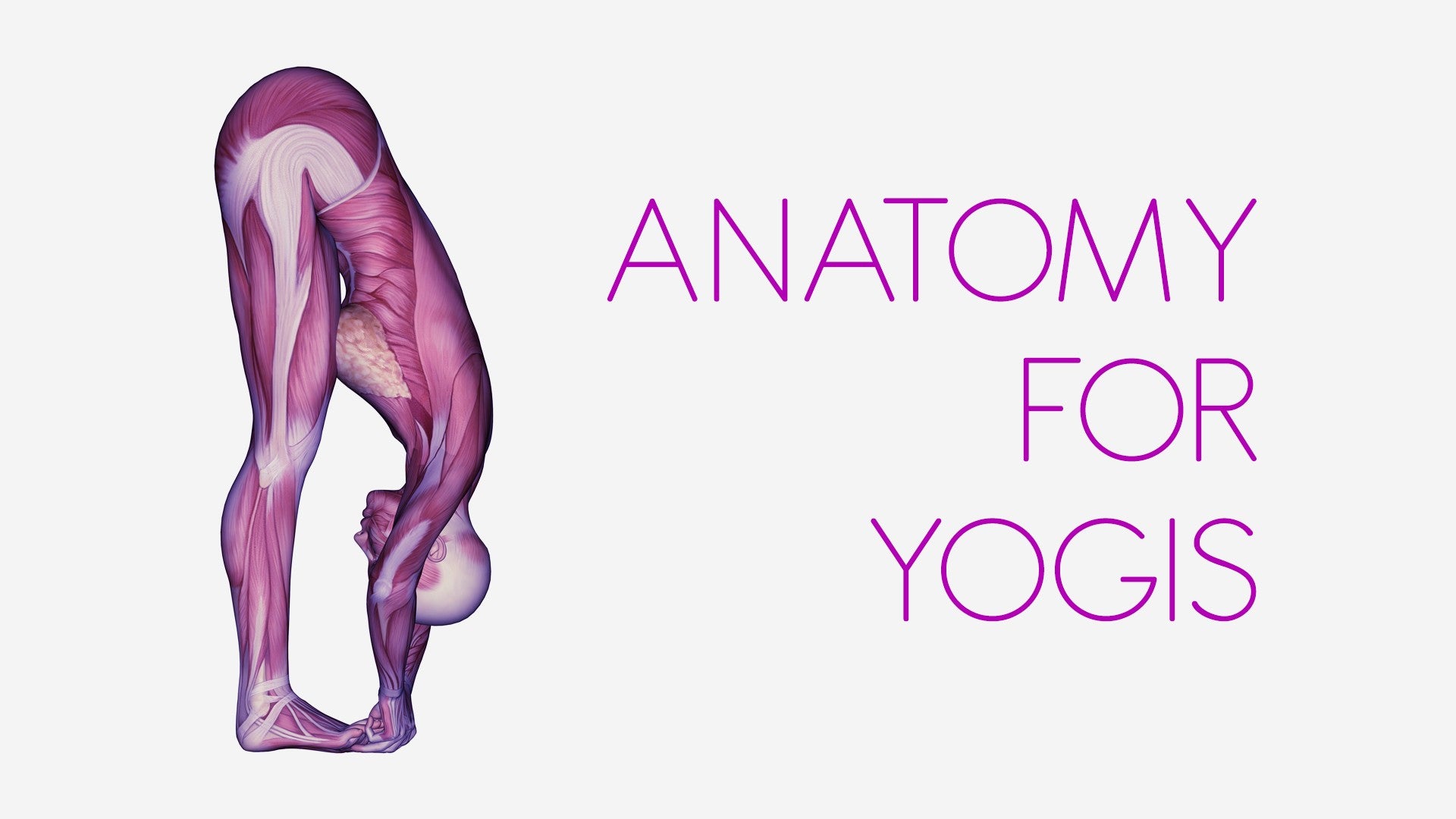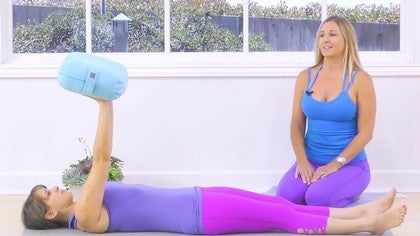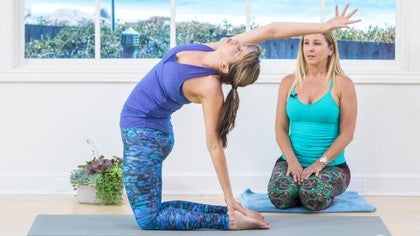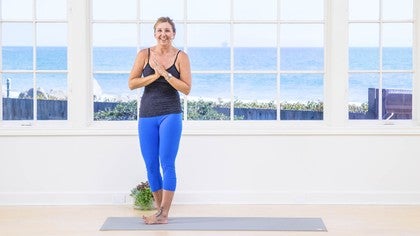Description
Transcript
Read Full Transcript
Hi welcome back I'm here today with Chelsea and she's my friend and assistant and we're gonna take you through part of a larger workshop that I like to call this is spinal map. So the workshop usually we spend quite a bit of time talking about science which I love and spinal biomechanics but there's a part of the class in the after the lecture we do class and there's a part of the class that I extracted just for you guys at home to practice today and it's just a shorter version of how to approach backbends through phases of rest and repetition. I'll give you a little bit of insight into spinal biomechanics but we will save that you know the discussion for something else. So what you'll need today is a bolster that's pretty much it if you don't have a bolster you can just grab a pillow off your bed or couch cushion the heavier the better so with some density some bulk to it would be great. So go ahead and lie down on your back and backbends can sometimes feel a little scary and people are oftentimes avoiding them I notice in classes because when the spine doesn't move and all the glorious ways that the spine can move the hips and the shoulders get overworked they end up overcompensating and so today's class we're really going to talk about moving through the spine as if it moved segmentally so teaching the spine to allow backbends to happen through all the segments of the spine evenly. So we'll start with just a short body scan you're lying on your back and I just want you to pay attention to your spine and feel what part of your back is touching the floor and what part is not. Notice if you're kind of leaning over to one side a little bit. Notice if you're angled or maybe side bent. Most of us have a little twist and side bend to us just in our natural posture. So see if you can start to identify what that is in you just so you can feel nothing that needs to be fixed or changed just notice it and then go ahead and bend your knees up so you're setting up for bridge pose and you're going to do a bridge but please don't think of yoga bridge don't think of a big asana I just want you to lift your pelvis up so as a test to feel the effort so just go ahead now push into your feet lift up your pelvis just notice what kind of effort it takes and then bring your pelvis back down it's just simply a test that's it nice okay and then go ahead and roll over onto your stomach and place your hands underneath you like a pillow with your hands place your right hand on top of your left hand and turn your left cheek down so you're looking over your right elbow and just rest for a moment there I had you do the bridge because we'll do we'll come back to it later and I want you to notice how sometimes all the instruction and cueing in the world sometimes can lead us astray and so this practice is really about gentle movement and repetition so that you can start to allow a more natural way of moving without overthinking it I know that sounds crazy because backbends are like so heavily instructed but you might find as we move along that you will be really receptive to the backbend and approach the some of the poses that you might normally not approach so while you're here go ahead and just lift your right elbow a little bit and then place it back down and then lift it again and place it back down and you're just going to repeat that and what you should notice is how you move how does the shoulder blade get involved in the process of lifting the elbow what's happening in your spine do you feel any movement in your spine what's happening in your ribs and if you're experiencing any pain or impingement in the shoulder just do less because it's not about doing it's more about noticing and then being able to do more later so we're just changing the way the brain perceives movement and that's just done through repetition and then from here rest your elbow down and then pick up your head and look over your right shoulder so you're just gonna lift up and look over and then put your head back down left cheek down and just repeat that repeatedly so these are known as somatic movements they're just gentle almost silly movements but if you really just be with it and repeat you'll notice that they get easier and easier they don't have to be difficult and they definitely shouldn't be painful do two more and then go ahead and rest for a moment if you need to turn your forehead down because you're tired of turning your head to one side do that just to neutralize your neck otherwise you can stay with your left cheek down and now we're going to add on you're going to keep your cheek pressed to your hand you're gonna lift everything so your elbow your hand and your cheek are gonna lift and you'll come back down so you're making sure that your hand and face are still connected and as you do this can you notice what's helping you in the movement do you notice your left leg contributing that's your contralateral leg on the opposite side and again what's happening in your spine what's happening in your ribs and what's happening in your pelvis nice and then rest go ahead and turn on to your back for a moment stretch your legs straight out and just scan the body again how does one side feel different than the other what were the effects of really non instructed just simple movements do you have a different relationship right now with your right shoulder than your left shoulder and then go ahead and roll back onto your stomach and we'll do the other side so left hand on top you're making a pillow with your hands turn your right cheek down and go ahead and start to lift your left elbow and lower it down and just keep repeating that there's no magic number you can draw this exercise out a lot longer which I've known to do but we're getting moving to backbends and I just want you to get the feeling that you can you can improve your movement just by moving I think sometimes we forget that especially in our world of yoga and Pilates we love to cue and instruct and you know moving is our gift it's our right and sometimes all movement doesn't have to be instructed when you learned how to walk you just experimented and you figured it out and that's your gate you didn't go to walking school and then from here rest your elbow down and start to lift your head so you're lifting your head looking up over your left shoulder and bring it down and while you're doing this and pay attention compare sides what was your right side like do you remember do you prefer your head turning this way or the other way just do a couple more and then rest you can turn your forehead down again we gave you that option on the other side otherwise you can stay here and now lift everything together elbow hand and face so that you're keeping the hand connected to the face and just lift everything up and notice what's your right leg doing is it helping and that's okay it's sometimes ridiculous to think that movement only happens in one place right what's your right arm doing are you using your right elbow to push and lift or are you not just do two more and then after that go ahead and turn around onto your back and rest and again scan notice your right side compared to your left side you're always going to feel uneven when you do things that are unilateral that happen only on one side because then you have to do the other side and that was the side that just happened most recently so we're not looking for even and balanced we're just looking for intention and awareness experience this increases your interoception and also your proprioception but even more your interoception and then go ahead and turn on to your stomach interoception is that your experiences of your inside how you inhabit your body the internal senses whereas proprioception is more where you are in space so like your interoception would be knowing that you have a hand or in this position you're on your stomach you can feel your feet you know you have them they have there's a sense of aliveness okay so now from here just go ahead and lift your head you're sorry you're making a pillow with your hands I haven't told you to do that doesn't matter which hands on top whichever you prefer and go ahead and your forehead is down you're gonna lift your head and look up like you're doing some sort of a cobra back bendy type thing and come back down and then again as you lift your head notice what's going on in the rest of your spine do you have a tendency to just break at the spine or can you feel that just looking up is sequenced through all of the segments of your spine all 24 movable joints in the spine well movable segments there's more joints in that and what are your arms doing and what are your legs doing to contribute to this and then go ahead and rest and now just lift your right leg up and lower it down and just repeat that a couple times again notice what's happening on your left side and your right side how are your shoulders either stabilizing or helping movement don't get attached to what you think should happen or what you've been cued just feel do one more with the right leg and then move over to the left leg and allow your spine to respond to the movement when you move it with you know somatic approach it's quite different because you're always trying to allow more things to move to make the movement easier and that's the way we're gonna approach back bends today rather than bracing here and holding there and firming this which I love to teach that but I also love all types of movement and sometimes just allowing things to be easy is actually such a gift it doesn't always have to be so hard do one more with your left leg and then rest pause for a moment and now you'll just do two of these you're just going to everything together you're gonna lift your head and lift both legs and come all the way up we're just doing a little back bend here and you should feel that this is very nice and casual and easy right this is normally one of those killer shalabhasana yoga poses you just find some ease and can your spine help through the movement and then come all the way down and rest turn on to your back please and place your hands by your side feel your body with your legs stretched out to start and then go ahead and bend your knees up put your feet on the floor and let's do another bridge test so just no no rules no instruction just just lift the pelvis up and just see does it feel easier to lift the pelvis now like good come on down and you didn't even do any bridges you just woke up the body so your experience of movement is easier okay so that was kind of our warm-up what we're going to do is we're going to work through a series of poses that is bridge pose and then we're going to do purvottanasana which is another back bend and we're going to move up to udvadhanirasana don't be scared we're gonna do many many sets but we're going to do them in this gentle way so that as we as we progressively make the poses just a little bit more challenging I guess are bigger but the body almost craves them and is hungry for them because we're building it up so we'll do three sets of 15 bridges okay so again don't think of like big yoga bridge shoulder stand holding effort you're just gonna lift up and lower down but I do want to teach you a little different way of doing this because I'd like you to really start manipulating the spine the spine has many curves and we can flex the spine and we can extend the spine and so as we do this bridge we're gonna treat the spine kind of like a slinky like it has this waving movement to it which it actually does so from here you'll press your tailbone down into the floor and you'll feel your back arch when you do that so press tailbone down and your lower back will arch up off the floor and then go ahead and do the opposite allow the tailbone to curl up and you'll feel your lower back press onto the floor so that's scooping the pelvis and then press the tailbone again and arch the back good and then scoop the pelvis so you're lifting the the tailbone this time and your lower back is coming onto the floor and now let that be what brings you up into bridge so you'll come up slow and as you go higher and higher you'll have to start arching the other way so keep your chest lifting just a little bit there you go and then round yourself back down one vertebrae at a time when you get to the end press the tailbone down so your back arches and then scoop the pelvis lift the tailbone so your back is sort of in this U shape right now and then you get to the top it's going to turn into an upside down U it's this slinky action and then lower down back into the U shape so you're just going through flexion extension and just keep repeating that you have 13 more and if that instructions a little bit confusing just it's okay you have to do it that way I'm just trying to get your spine to start moving fluidly like a wave and do whatever you need to do to start experiencing that again don't push to your highest range just feel the fluid movement it should be at about five I'm not going to keep strict count notice what's working here what are your legs doing how are your arms helping don't try and apply alignment rules to this don't try and find the answer to the glute debate here just just go up and down and notice notice what works notice what your feet are doing are your feet even evenly placed don't change it if they're not just notice that should probably be around 9 or 10 now so just do a few more again 15 is not the magic number but it's it's a large enough volume that there's some serious learning going on here we're learning how to move like when you're a little kid and you're learning how to crawl again didn't go to school for that you just experimented you just noticed if you kept looking over your shoulder eventually you rolled onto your stomach it just happened and that's what you're doing now you're just lifting and learning nice just do one or two more finish up your 15 if you were counting fine if not you can just come along right along with us and then when you're done with that one you will stretch your legs out and rest and while you're resting just observe are there any movements that the body is craving if you have this urge to like crack your back to realign yourself if it's painful of course do but otherwise resist that urge I notice that I'm always trying to when I do this work afterwards try to realign myself back into that crooked position that's so familiar so allow yourself just to adapt to whatever changes are happening and then bend your knees up and let's repeat again you're sort of slinking waving your spine up you press your tailbone down first to arch the back and then you scoop it the other way to lift up so when you lift up your back is rounded opposite of the way we do it in yoga but then when you get to the top it sort of turns into a yoga bridge and then you scoop down and just keep repeating I like to say this is kind of a blend between the Pilates bridge and the yoga bridge best of both worlds just notice I'm kind of coming up with some cues for you because I'm watching Chelsea I can't watch you at home but you know do you push with your feet or do you pull with your feet to come up don't change it just notice did you put your feet in the same spot as you did last time because you've had stretched your legs out in between or are they in a different spot are they turned out probably not because you've been told so often not to turn your feet out in this pose but just notice if you're not thinking about alignment what is your body want to do great about three or four more probably and then after you've finished those three or four more take your time you'll stretch your legs out and rest and then one more time bend your knees up feet flat on the floor and go ahead and start to curl up just a little bit same way as before and observe what's working are your legs getting tired a lot of bridges how about your arms and your shoulders what are your shoulders doing how are they related to the floor as you go through the spinal motions as you go through the arching and the rounding what is your head doing do you like to push your head into the floor to really stabilize that neck or can your head just go with the movement can you allow your chin to just nod in response to what the rest of the spine is doing I find that's really hard for us in yoga we're always telling ourselves where to put our head and not just letting it flow with the movement should have about five more left so go ahead and finish those and after you finish the next two something like that you'll stretch your legs out you'll rest and just feel okay so go ahead and bend your knees up and roll over to your side and just have a seat you'll stretch your legs straight out in front of you your hands will go behind you so pour vote in Asana is arms behind you arms straight it's eastward facing plank pose and you'll reach through the balls of your feet and lift your pelvis up coming into a backbend and do two sets of ten you can have your fingertips face your body or you can have the fingertips turn out whatever is comfortable for your shoulders and again I don't want you to think of pushing into the top of the pose just ride the wave of the pose let the spine move and see what happens okay so when you're ready you'll push into your hands reach through your feet lift yourself up feel the spine articulate and then come down so you're not gonna hold long you're just gonna repeat adjust your hands as you need to just like Chelsea did that was great and slowly come down and here I will give you a little bit of guidance you have to use your legs you have to use the back of your legs otherwise you'll get fatigue really quickly in the upper body and just feel how the spine responds as you lift and lower and you should be about halfway done you can let the head go if you'd like you can look straight ahead but if you start to take the head back see if you can have it be a response to the rest of the spine so as the spine arches the neck goes with it instead of having like a break at the cervical spine which we so often do good probably about three more use your legs to prevent the arms from overworking and then last one and then you get to rest the resting is the best part right you can just lie back onto your back so these little mini Shavasanas are like where all the magic happens this is where the nervous system has a chance to process what you've done you'll notice a lot when I teach classes I'll say you know after we do one leg I'll say feel the difference between the legs because you don't take the time to observe it it's almost like it just it's a passing experience and you really want to lock it in and let the nervous system adapt to it we forget that our brains adapt just like other tissues in our bodies adapt and go ahead and come to seated you can just roll up or you can roll to one side whatever you prefer and let's repeat so it's our second set of ten so hands go behind you in a comfortable position and then when you're ready you'll reach through your feet and lift up the reaching through the feet helps you connect to the legs and again fill the spine it arches when you get to the top and it rounds when you come down nice notice if your head is doing the same thing as last time or if it's different you're about halfway there don't push and if this is becoming too challenging because you're tired it's fine lay on your back and do bridge pose and that goes for you too Chelsea so you don't have to keep going right this is the this is the thing here you just want to keep the spine moving if you're if you're doing too much for your body right now in this moment back up a little bit and do the previous one and when you're ready lie on your back and rest about ten so even if as we move to Urdhva Dhanurasana now the early stages of it again please don't feel like you have to do them bridge pose is a perfectly acceptable practice you just want to move the spine before we move into Urdhva Dhanurasana we will do a little bit of a shoulder warm-up because I just as a yoga teacher can't just don't feel good about putting you right up into this pose without warming up your shoulders because the shoulders do go into quite a bit of flexion so that's what your bolster is for so you'll take your bolster you'll stretch your arms straight up and you'll place your bolster on the hands and so now you're just going to do some reverse push-ups basically the weight of the bolster will warm up the shoulders faster you'll take your arms all the way overhead nice and slow mm-hmm keeping control of the bolster and bringing it back up so I love the way to the bolster I think it really gets you right in the shoulders right away but what I want you to get in this exercise is the opposite of what we often do in yoga when we do this as a lat stretch let the spine move so if you don't let the spine move your shoulders have to do all of the work they have to go into full flexion all the way and that's not really very comfortable for many people even if you don't you might not have the bone structure for it so as you take the arms overhead can you feel your spine and your ribs arching trying to help your shoulders move and as you bring the arms up can you feel the spine and the ribs sort of flexing and rounding down toward the floor to help bring the arms back you do about three or four more how's that okay so when you go into Urdhva Dhanurasana this is what has to happen the spine the shoulders have to work together not against each other they'll make the movement much easier good last one and this is really useful I think because it's your down dog plank down dog plank as well you can use this exercise for all sorts of warm-ups and then I'll take the bolster and just rest notice your shoulders okay so bend your knees up and place your feet flat on the floor bring your hands by your shoulders you're gonna set yourself up for wheel pose so what you're going to do is come up onto the crown of your head and not all the way into the full pose and you're gonna do it five times and you're going to do it like it's a very simple smooth slinky type spinal movement so again don't push hard just start to come up if your head doesn't actually touch the floor it's fine you're just gonna come up and come back down just like we've been doing all the other poses so when you're ready push into your hands and feet come on up and come back down that's it feel how the spine moves really come down one vertebrae at a time and again come up feel the spine extend and then flex as you come back down after you tuck your chin again good and come back down nice again and come back down last one and if this is too much at any point do bridge pose right it's just about moving the spine I don't care about the pose the pose is like inconsequential and then pause and rest stretch your legs out just notice notice what happened how did you move how did you adjust your feet in order to make the movement more fluid you probably broke some yoga rules okay last one you're gonna do the full pose one time again if this is like not for you if you don't feel like you're ready and you're warm to do this pose just do a bridge pose one time it's perfect it's not like a lesser I just want you to feel your spine move so if you're ready bend your knees up I'll cue the Urdhva Dhanurasana bring your hands back by your shoulders and then you'll come up and just be in the pose for a couple breaths okay and while you're there explore what did your body do to make this pose accessible for you don't push that's where we get into trouble that's why the that's why alignment does matter so much because we push into things just let let it be a gentle natural movement okay when you're ready come on up nice very good take a few breaths feel your spine arching and working with the shoulders and the legs notice how the legs are working to help you and then when you're ready tuck your chin and slowly roll down rolling down one vertebrae at a time and stretch your legs out and rest and just feel the back body do you have a different relationship with how your spine works in this poses the mechanics of the spine are really fascinating because of all the changing curves it's a very very complex system more than half of the joints in your body are in the spine and rib cage area in the in the axial skeleton if the spine wasn't meant to move in a huge variety of ways why would we have so many joints there that's the big question right and I think it we tend to get very stuck on this is how the spine should move this is safe for the spine and as a result we take away movement options so one more time put your feet flat on the floor bend your knees up and just do one bridge pose to test just it's your test again just don't even think about the just lift your pelvis and notice is you might be a little tired but you might have so much lift with very little effort and then lower down how was that and then from here just gently bend your knees into your chest take your arms out to the side you can just be in cactus arms whatever is comfortable just drop your legs over to the left bring your knees up toward your shoulders so that you're getting some rounding in the lower back just to do something different for the back and then go ahead and roll over your sacrum and make your way to the other side and then roll back into the center go ahead and hold on to your legs just round your spine pull your knees into your chest curl up just a little bit and then go ahead and stretch everything out and rest can you remember how you felt when you first started the practice and I don't mean like felt good felt bad I just mean what what was touching the floor how is your spine were you rotated were you side-bent can you remember that do you have a snapshot in your mind of what it was like to be in your body before you moved and can you compare that to the snapshot that you have now if your eyes aren't closed be sure to close them and if you didn't go all the way up to Urdhva Dhanurasana at the end and you state you went back to a bridge that's perfect you're in the perfect place but I would advise you to come back to this practice somewhat regularly just to see how your body changes the more you introduce these movements to it and again this is meant to be a gentle practice even though we just did 45 backpens in 30 minutes it wasn't meant to be challenging it was really meant to be sort of brain opening not body opening but that the mind understands movement better that was the whole intention behind it and if you'd like to stay in Shavasana for another five six seven minutes I fully support that if you'd like to close the class with us then you can go ahead and slowly wiggle the fingers in the toes you can stretch your arms overhead and then go ahead and bend your knees up roll over to one side use your top hand on the floor and press yourself all the way up to seated your head comes up last find a gentle comfortable position to sit crossing the legs you can go lean against a wall or couch or something comfortable rest your hands on your thighs and gently close your eyes and then go ahead and join your palms together at your chest gently bow your head down just feel the ease in the seated posture we're meant to move and moving should be easy and gently lift the chin open the eyes bring your hands down thanks for joining us today thanks Chelsea namaste
Anatomy for Yogis: Jules Mitchell
Comments
You need to be a subscriber to post a comment.
Please Log In or Create an Account to start your free trial.














